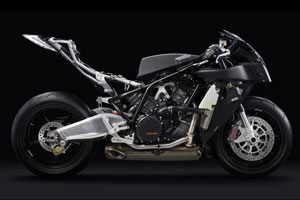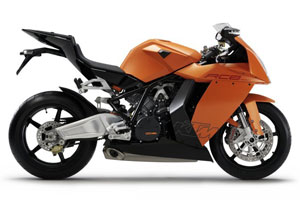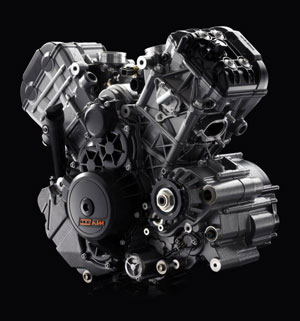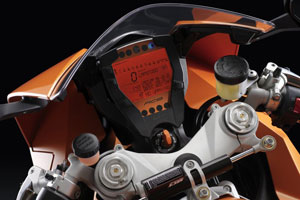Moto Online takes KTM’s brand new 2008 model 1190 RC8 superbike contender for a blast around the Creek and streets.

SPECIFICATIONS
ENGINE
Engine type: 2-cylinder, 4-stroke, V 75
Bore x stroke: 103 x 69 mm
Displacement: 1,148 cc
Compression ratio: 12.5:1
Transmission: Six speed
Power (claimed): 153hp
Torque (claimed): 89ft-lbs
CHASSIS
Frame type: chromoly trellis frame, powder coated
Front suspension: WP USD 43mm
Rear suspension: WP Monoshock
Wheelbase: 1430 mm
Wheels (front/rear): 3.50 x 17″ / 6.0 x 17″
Tyres (front/rear): 120/70 ZR 17″ / 190/55 ZR 17″
Brakes (front/rear): 2 x Brembo 4-piston fixed caliper, radially bolted, 2 x floating brake disc 320mm / Brembo two piston, fixed caliper, 220 mm brake disc
DIMENSIONS
Weight (claimed): 188kg
Seat height: 805/825mm
Fuel capacity: 16.5L
PURCHASE DETAILS
Price: TBA
Colour options: Orange
Test bike from: KTM Australia (www.ktm.com.au)
Attractive would be the wrong way to describe a high-powered superbike. But the sharp, sleek, orange lines of KTM’s 1190 RC8 just keep drawing my attention as I gaze at it over and over again.
It is an attraction though, so I guess that would make this particular bike attractive in a sense. Eyeing off every piece of it from front to back, the RC8 has my mind racing with thoughts.
As an avid dirt bike rider and a big fan of KTM’s off-road range, the Austrian manufacturer’s first serious crack at on-road performance motorcycles has me eager to find out how it goes.
The Super Dukes have impressed all who have tried them out over the years, although this is it. KTM’s first assault at taking on the big guns in road riding’s premier superbike category.
I’d never even ridden a Super Duke before my spell on the RC8 at Sydney’s Eastern Creek Raceway in New South Wales, so my first taste of the RC8 when I hit the track are my first ever impressions on KTM’s on-road capabilities.
Out of the pits and on to the track after the mechanics had warmed the roaring 1148cc 75-degree V-twin engine in pit lane, I’m literally stunned at just how easy the bike is to jump on and have a blast on straight away.
When looking at the bike in the pit area I thought it would feel a little strange as the seating position looks really low when compared to handlebars and fuel tank height, but once on-board it all balances out to become a comfortable ride.
Tipping in to Eastern Creek’s Turn Two, I’m shocked to feel my knee touch the deck briefly, and that is self explanatory of the bike’s low seat height of 805mm in standard form — the lowest of any bike in the class.
Its low seat height is joined by high-ish handlebars, while the footpeg position is comfortable and set in a natural position.
Adjustability is the key with this bike, as the actual ride height can be changed via the rear suspension linkage, the seat height can be moved up 20mm with duel mounting holes on the bolt-on subframe, the ’bars can be adjusted up or down, as can the ’pegs.
Your wish is the bike’s command as far as rider comfort goes.
The standard set-up features the seat- and ride-height in the lowest possible positions, as are the ’pegs. The ’bars come with sleeves in them that sit them a touch lower than the triple clamps and it can be removed if you want them higher or lower.
For a shorter rider like me, the low settings make the bike comfortable almost instantly. The 1190 RC8 is confidence inspiring from the very beginning. It is obvious that the bike is designed with racing in mind (as proven by KTM’s participation in the Superstock 1000 FIM Cup) and it performs up to scratch on the track.
Funnily enough, the low seat height and the way that it wedges the rider low in the cockpit kind of reminds me of Casey Stoner’s Ducati Desmosedici MotoGP racer.
The WP suspension performs excellently on the smooth surfaces of Eastern Creek’s 3.93km road race circuit, with the fully-adjustable rear mono-shock taking everything I can give it and its Pirelli Supercorsa Pro tyres.
Up front, the fully-adjustable 43mm forks do an impressive job too, although the odd bump in the surface causes limited upset as the forks rebound too quickly. More time to dial it in to my liking most likely would cure this, but we will soon see at our upcoming comparo.
Its claimed light weight of just 188kg (without fuel) makes it a touch heavier than most of the other manufacturer’s claimed weights, although the RC8 doesn’t feel heavy at all and is quite planted and stable.
The adjustable WP steering damper mounted to the bike probably aides the stability and it is responsive to adjustments, as are the suspension changes. Overall the chassis, which features a chromoly trellis frame, performs exceptionally well on track.
Brembo brakes are mounted front and rear, with the Monoblock front callipers mounting on to the 320mm discs proving to work superbly, as they do on the likes of the 1098 range. The rear features a twin-piston calliper on a 220mm disc.
Sometimes upon hard braking into the turns, the back-end slides big time as I slam on the picks, although it remains in control and the chassis responds greatly — quite surprisingly as most twins like to be kept with the wheels aligned.
I guess KTM’s promotional video which shows the RC8 sideways on numerous occasions was a true indicator of the bike’s performance.
It’s a mix of the braking power, chassis set-up and vast engine braking that makes it want to move around so much under braking.
As you can see, a lot of the components on the RC8 are the same brand as what KTM has used and trusts on all of its off-road machines.
One component that does stand out is the use of Marchesini wheels.
Engine wise, KTM has created a motor which places the bike in comparison with Ducati’s outstanding 1098 range, with the bike’s specs and price range matching it comparatively with the standard 1098.
On track, the claimed power figure of 153hp and 89ft-lbs of torque falls just short of Ducati’s 160hp/90ft-lbs standard, and it is very noticeable. Although the KTM is lacking slightly in the power ranks, especially punch off of the turns, its useability and power delivery will still enable it to set blistering laps.
I won’t be surprised if the bike is very competitive at our upcoming track test — especially with the less experienced track riders onboard.
The power comes on in a smooth manner from low in the rev range and pulls to around 9500-10,000rpm — although the shift bright shift light can’t be missed at its setting of 9,500rpm. The impressive dash reads to 12,000rpm, although the redline is around 10,500rpm.
Into the corners the KTM’s mega engine braking causes a little drama, because as soon as you are completely off the throttle the engine brake acts like an anchor. This is okay on corner entry when under brakes as the slipper-clutch helps the engine spin freely, but once mid-corner where corner speed is vital, I found the engine brake to kick in too much and slow me down far too much.
Some have experienced difficulty entering turns and finding false neutrals when down-shifting, but I never experienced that. The gearbox is more notchy than its competitors, something that KTM will most likely fix in the future.
The effect forces me to add a touch of throttle mid-turn, earlier than I usually would, meaning I have to be very precise that I don’t give it too much. This isn’t a massive problem, although most bikes do carry that bit of extra rolling speed through the corners.
Speaking of the dash, KTM has almost everything covered with the groundbreaking digital unit. I say almost because there isn’t a gear indicator, but there sure is everything else.
With separate road and race modes, the race one the race mode that I use at the track features laptimes (best and last), top speed, race odometer and maximum rpm — all re-settable for each session.
The road mode features a fuel distance indicator, fuel trip metre and air temperature.
Both modes have a handy service interval indicator, average speed and the usuals such as odometer, trip metre, time, engine temp etc. Also featured are the usual warning and indicator lights.
That’s a lot of options to take in for one dash, although it’s adjustable by either touching the dash or by using a trigger-styled button (either pull with index finger or push with thumb) on the left clip-on.
After my first dance at the Creek, an exclusive road test is organised to get a feel for the orange racer to allow me to sample it in the real world.
All indications of its solid track performance pointed at it to be an awesome street bike, with the neutral ergonomics of the RC8 slotting in as a top range fully-faired sportsbike that is still comfortable for longer rides.
Shieldsy and I tested that exact feature of the bike in a lengthy day run of over 600 kilometres, with the RC8 proving to be as comfortable in touring mode as it is in performance mode.
And that’s really saying something, because that mix between on-track performance and street comfort has been quite separated in recent years. The KTM is the most versatile bike in the superbike category today as far as the comfort/performance ratio goes.
Back pains are minimal, neck strain is lessened and hand cramping is put to bed — expect for the throttle hand, which got a bit tired due to what feels like a slightly heavy throttle.
The only other complaint is that the race-styled seat begins to feel kind of hard after a long stint. Overall, the ergos are good and the RC8’s adjustability means that almost any size rider will fit and be pleased.
Reaction to the bright orange beast around the public roads was phenomenal. A standout in the crowd, KTM’s blaze colour scheme is new and distinctive out and about. One time when I’m following Shieldsy and he is on the RC8, the KTM’s presence sent a group of bikers into a small frenzy.
The cool-factor with the KTM is high and it definitely is one of a kind at this point. The long vertical lights at the front and rear are yet another feature of individuality.
Integrated front indicators into the mirrors look good as well, although vision isn’t 100 percent. You can see better than most, but a little more length to each side would have made a big difference. I also experience slight difficulty during U-turns as my gloves hit the mirrors when on full lock.
As with the track segment of my test, the 1190 RC8 performs at its best on smooth surfaces, proving easy to turn and manoeuvre while holding its lines exceptionally well.
Bumps throw it off line more than what I’d like, unsettling the front suspension and causing me to have to sit it up and run that little bit wider. Some fettling would help aide this.
Whether it is small ripples in a corner or nasty bumps in s straight line, the forks spring back in a quick manner, forcing me to take action to keep it in full control on occasion.
The rear, just like at the track, is excellent. It tracts to the ground in a manner that inspires confidence with more time on the bike — soaking up most bumps and giving plenty of feedback. It does feel a touch stiffer than some bikes though.
Troubles with the gearbox shine through on-road more than they did on the track, causing difficulty in shifting and selecting the right gear at times. It’s harder work to get it into gear than most, even making it hard to get it into natural at times.
Having the clutch fully-engaged while up-shifting is very important along with precise foot movement to get it done correctly.
It’s about the only true flaw with the RC8 that stands out, essentially meaning that KTM has done a wonderful job at its first superbike attempt. It’s also hard to understand because the Super Duke’s ’box is really good.
I don’t expect this to prove a problem for long — whether KTM produce a quick-fix part for this year or revise the gearbox for the next model, it will be fixed.
Engine power is impressive in street-trim, and although it lacks the outright power of the Ducati 1098 on track, that gap is less relevant on the open roads. Its broad power likes to be held between 3500 to 5000rpm, and I find myself using fourth to sixth gears the majority of the time.
At times the gearing feels a little tall, forcing me to shift back that extra gear at times where I would usually lag it in the higher gear. Never mind though, that’s an easy fix and personal preference.
The throaty bark out of the engine is deep and strong via the underslung exhaust and is sure to catch almost anyone’s attention.
Fuel economy is quite good for a big engine, using 6.7L per 100km with a good mix of tight riding, open roads and freeway riding.
With a first effort of building a bike to go head to head with the best bikes in the superbike category, KTM has done a wonderful job. With great handling and a solid engine, this bike is here to stay and is even better than some of its experienced rival bikes.
A few refinements would make it a little better, but apart from that it is a true contender in the class. The first model always reveals a few minor glitches, but this model is the first of what is going to headline KTM’s growth in the on-road market.
Game on for the boys in orange.










Newsletter